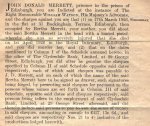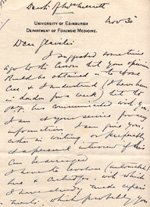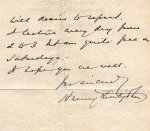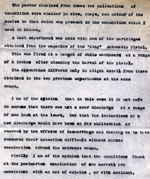Case against John Donald Merrett (1926-1927), Edinburgh
John Donald Merrett was accused of the murder by shooting of Bertha Milner or Merrett in 1926. In January 1927, Merrett was tried at the High Court in Edinburgh and found guilty on a charge of forgery and sentenced to 12 months imprisonment. A verdict of 'Not Proven' was returned on the murder charge. Sir Bernard Spilsbury (Home Office Pathologist), Professor Harvey Littlejohn (University of Edinburgh) and Professor John Glaister Senior were involved in the trail. Much of their evidence centred on their knowledge of ballistics.
 |
Indictment against John Donald Merrett, January, 1927 Ref: GUA FM/2B/20/5 The trial of the Edinburgh student, John Donald Merrett, on charges of murdering his mother and forging cheques to the value of £457 began in the High Court of Justiciary, Edinburgh . The indictment records approximately 186 productions and 57 witnesses. The principal witnesses were a charwoman who told, how she was busy in the kitchen, she heard a shot and a thud. Immediately afterwards the accused came to her and told her that his mother had shot herself. |
 |
Taken from Scrapbooks entitled 'Trial of John Donald Merrett, High Court Justiciary, Edinburgh' Ref: GUA FM/2B/20/7 The principal witnesses were a doctor and the nurses who attended to Mrs Merrett in the Edinburgh Royal Infirmary. They gave evidence as to what the deceased lady said to them with regard to the occurrence when she regained consciousness a few days before her death. The medical experts called by the Crown were Professor Harvey Littlejohn, Professor of Forensic Medicine at the Edinburgh University and Professor John Glaister Senior. The Crown also called a firearm expert, Mr Alan Macnaughton of Edinburgh. The prosecution relied on general circumstances of shooting. Evidence was given by Professor Littlejohn, who submitted reports prepared after post-mortem examination of the body of Mrs Merrett, and after shooting experiments made with a pistol. In the first report the Professor said that from the position of the wound the case was consistent with suicide, but in the second report he gave it as his opinion that suicide was in the highest degree improbable, the direction of the bullet, the position of the wound, and the distance at which the discharge took place all pointing to the weapon having been fired by another party. The wound from which Mrs Merrett died had been produced by a small, light automatic pistol of Spanish make. The bullet had entered her head through the right ear and had lodged in the base of the skull. |
  |
Correspondence between Harvey Littlejohn and John Glaister Junior Ref: GUA FM/2B/20/1 Harvey Littlejohn suggested that the position of the wound was unusual for suicide, he argued against suicide, but suggested that this may not be conclusive. He ruled out the idea of an accident, to do with the angle, distance from which the revolver was fired and great extension of shoulder joint required. Littlejohn first saw the wound at the post mortem, which occurred two weeks after her admittance to the Edinburgh Royal Infirmary. It was the lack of blackening and tattooing which led Littlejohn to suggested that the gun must have been fired by a third party at some distance. Aided by Glaister and using the same pistol and same kind of ammunition they did some experiments in shooting pieces of white cardboard and even pieces of skin. |
 |
Taken from Scrapbooks entitled 'Trial of John Donald Merrett, High Court Justiciary, Edinburgh' Ref: GUA FM/2B/20/7 Craigie Aitchison, acting for the defence, suggested that the circumstances were consistent with suicide or with accident. The defence also had the services of Mr Churchill, one of the best-known firearm experts in England and Sir Bernard Spilsbury, Honorary Pathologist to the Home Office. |
 |
Precognition of Sir Bernard Spilsbury, 1927 Ref: GUA FM/2B/20/4 The defence argued that a pistol discharged within three inches of the head will not only project the bullet into the head but will also inflict damage on the skin. The flame of the discharge will cause damage, and the smoke will cause blackening of the skin, however Mrs Merrett's wound had been washed on her admittance to Edinburgh Royal Infirmary. The doctor who admitted her to hospital stated that there was no blackening by smoke or tattooing of her skin then. Spilsbury, after carrying out shooting experiments in London and Edinburgh said that in his view there was nothing inconsistent with Mrs Merrett's wounds having been self-inflicted with suicidal intent. Churchill also described experiments carried out by him. |
February 9th, 1927
The jury, after an absence of 55 minutes, found the charge of murder not proven. Some thirty years after the trial Merrett, under suspicion for murder, committed suicide.
Associated material
- Royal College of Physicians, Edinburgh, Sir Sydney A. Smith Collection, 'Subject Files-Cases'.
- National Records of Scotland, Ref: AD15/27/1 Precognition (2 boxes); Ref. JC5/17 Book of adjournal, Ref. JC26/1927/27, case papers; Ref. JC26/1927/18 X rays of Mrs Bertha Merrett's skull.
- Royal London Hospital, Ref. GB 0387 PP/SPI: Forensic medicine microscopic slides of Sir Bernard Spilsbury (1877-1947) Knight, Pathologist
Publications
- Roughead, W. (ed.) (1929) Trial of John Donald Merrett (Edinburgh: William Hodge & Co.).
- Tullett, T. (1956) Portrait of a Bad Man (London: Evans Bros.).
- Wilson, J.G. (1960) Not Proven (London: n.s.).

